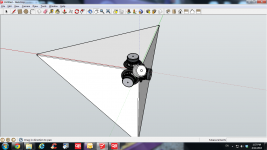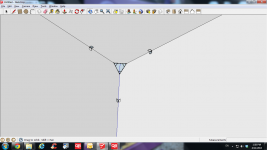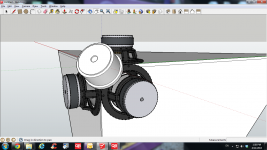Directivity control for the masses may be "almost inevitable", but it will likely be achieved using beam steering with multiple tiny drivers each with dedicated DSP and amplifiers, as in some "sound bars" already available.It seems to me however that this speaker design or variations of it becoming standard fare is almost inevitable. The positives far outweigh the negatives.
Whether there is a Synergy or any other horn in your corner, the physical size (and expense) of a horn that has uniform directivity down to below 400 Hz will outweigh the positives to most of the buying public.
Again , all of this is solved by simply using a trihedral shaped Synergy corner horn right?
No, because there's a reason why the tweeter is placed at ear height in the configuration Simon was talking about...
Obviously my point of view is skewed by me being an audio fanatic/professional/etc, but I can see a couple of scenarios very likely to play out. Our large speakers may finally become, as they are in our cars now, an architectural feature. The Synergy corner horn idea is an incredibly perfect application for this. The other part is going to happen in our bodies an implant perhaps. Let's face it no one likes 100 lb speakers but everyone loves 100 lb audio.
No, because there's a reason why the tweeter is placed at ear height in the configuration Simon was talking about...
One of the reasons I put the tweeter at (sitting) ear level is that the design was made with a ribbon tweeter in mind, so you don't want to be too far off the vertical axis for optimal results.
But even with a wide vertical dispersion tweeter it doesn't sound "natural" to me if the tweeter is too much higher or lower than the listener. For a typical 3-4Khz crossover to a tweeter its the height of the tweeter that determines the "apparent height" of the sound source, since frequencies around 8Khz provide the primary height cues.
If the midrange driver is slightly below ear level below the tweeter it doesn't matter because the frequencies between 300Hz-3KHz provide very little if any contribution to perception of height. (or elevation to be more technically correct)
I wonder if people would really object to the ceiling point source? I suspect they would not. I would imagine an invisible (but fantastic sounding) speaker would be "mildly popular" with the ladies to say the least. I would also suspect that should we survive the current attack on civilisation, the "theater room" will become standard fare in a home. It is too seductive not to.
No, because there's a reason why the tweeter is placed at ear height in the configuration Simon was talking about...
Why the new objection to ceiling corners for point origination now? The power mad ruling female class has been forcing decent practical men to put those little B*se pieces of crap at that juncture for decades. Why choose now to grow a pair and put your equipment where it really should be?
Last edited:
The imaginary Tet corner horn could be a reality I'm a matter of hours for many of us. Make that 10 minutes for Bateman. (-:i
Okay, you guys that don't like the vertical aspect of the imaginary trihedral synergy horn can go with the imaginary 1/4-cylinder floor-to-ceiling electrostat corner panel. I'll take two of each, please.
Why the new objection to ceiling corners for point origination now? The power mad ruling female class has been forcing decent practical men to put those little B*se pieces of crap at that juncture for decades. Why choose now to grow a pair and put your equipment where it really should be?
Easy there, those B*se people have just offered me a job!
David S.
Actually I thought of something that could conceivably make this idea happen quick for all of us interested. Stay tuned.(-:
Quick corner ... speaker! Well ...
Classic Radio Shack 40-1197 (FE-103 clone) [2 screws, 2 nails]
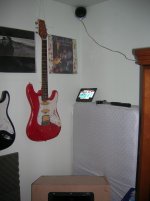
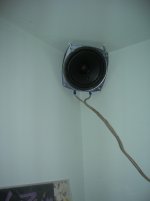
And FE-83 [just 2 screws! Super quick!]
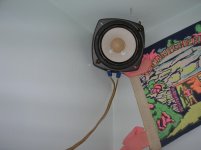
Playing Satriani's Wind in The Trees from an old P4 desktop with SoundBlaster Live! PCI card (SPDIF out!) to my old Art DIO DAC and then on to a souped-up TPA3116 digital amp ... Sounds good! ...
Last edited:
I was thinking the same thing.
I remember having one of those OMG moments listening to a small paper full range open woofer (I was holding it in my hand) driven by an almost current source class A amp. It was the cleanest couple of octaves I'd heard at the time.
AudioLapDance, maybe some cardboard stuffed around the edges might show whether this a step in the right direction.
I remember having one of those OMG moments listening to a small paper full range open woofer (I was holding it in my hand) driven by an almost current source class A amp. It was the cleanest couple of octaves I'd heard at the time.
AudioLapDance, maybe some cardboard stuffed around the edges might show whether this a step in the right direction.
Back in 1980, I made a really small constant directivity cornerhorn like some of those we've been talking about in the last page or two. Most of my designs were larger three-ways, but I got a request for a small system, so I used the JBL 2115 in a small wedge-shaped cabinet, quite similar to what you guys have been talking about over the last few pages. They're cool, so small they can be tucked back deep in the corner, nearly flush.
I still love that JBL 2115 driver. It didn't handle much power, so SPL was limited. But it was a great full range speaker. It's unobtanium now, having long since been discontinued. You can't even get recone kits for them anymore.
I think Fostex makes something like the JBL 2115 now, so if I were going that direction, I'd probably look at one of their drivers. The Fostex F200A looks nearly identical to the 2115, both in physical appearance and in performance, and I'll bet it would sound great in one of those little "wedge" cornerhorns.
I still love that JBL 2115 driver. It didn't handle much power, so SPL was limited. But it was a great full range speaker. It's unobtanium now, having long since been discontinued. You can't even get recone kits for them anymore.
I think Fostex makes something like the JBL 2115 now, so if I were going that direction, I'd probably look at one of their drivers. The Fostex F200A looks nearly identical to the 2115, both in physical appearance and in performance, and I'll bet it would sound great in one of those little "wedge" cornerhorns.
I still love that JBL 2115 driver. It didn't handle much power, so SPL was limited. But it was a great full range speaker. It's unobtanium now, having long since been discontinued. You can't even get recone kits for them anymore.
Thats pretty much a pro version of the LE8t. (No Lansaplas?) Most of those models are interesting because they used a long gap, short coil geometry. The LE14 had really nice bass with that geometry.
David S.
- Status
- This old topic is closed. If you want to reopen this topic, contact a moderator using the "Report Post" button.
- Home
- Loudspeakers
- Multi-Way
- Uniform Directivity - How important is it?
